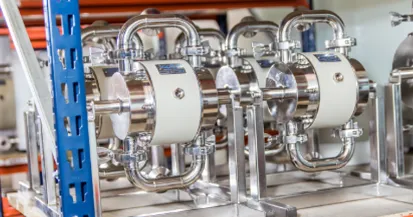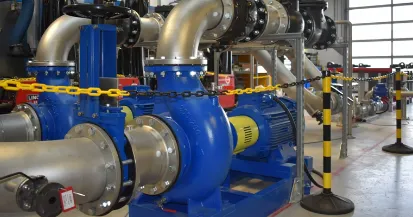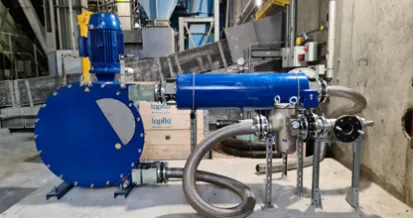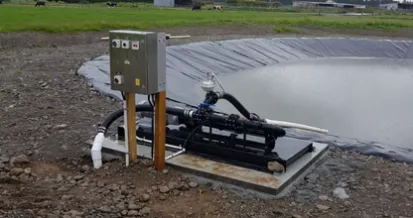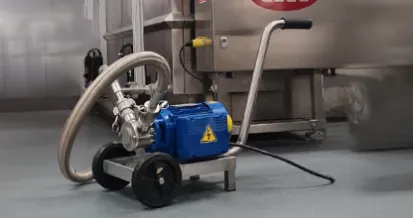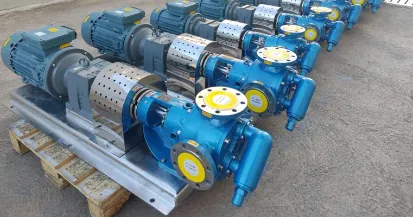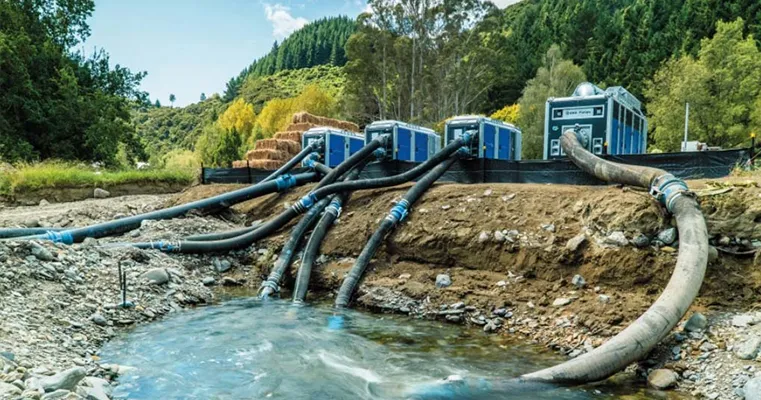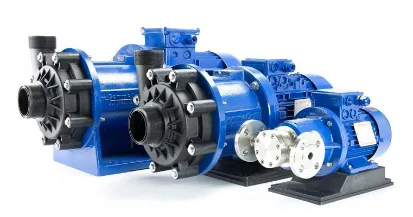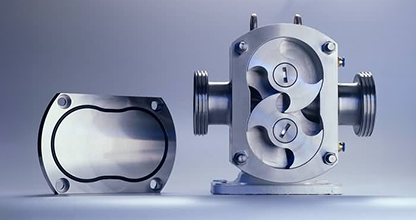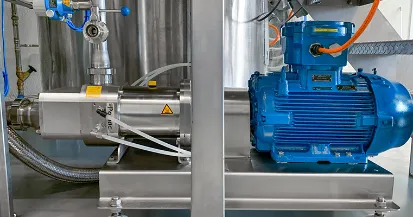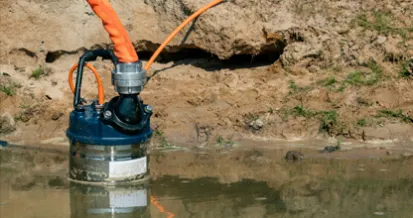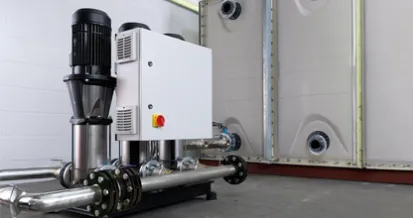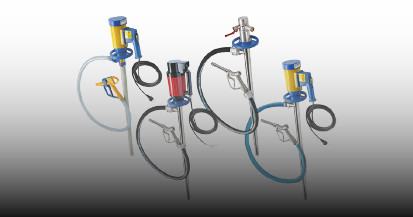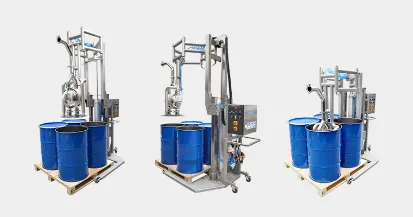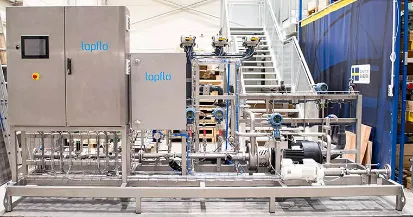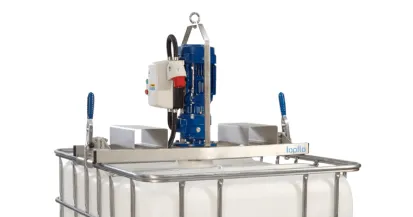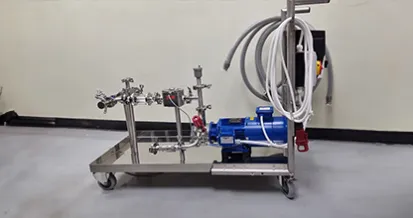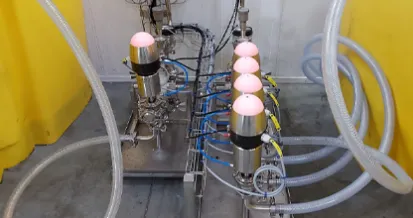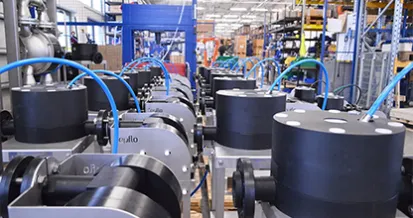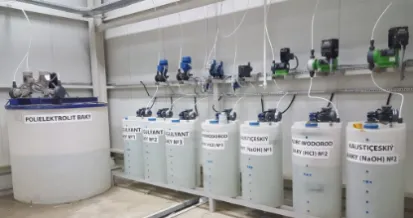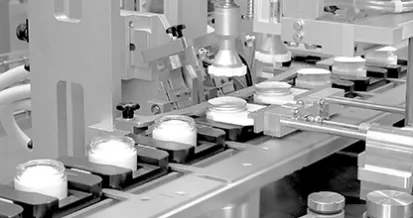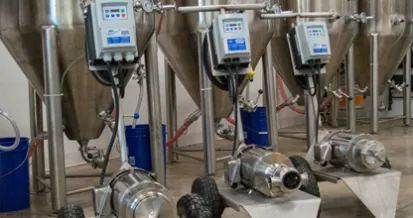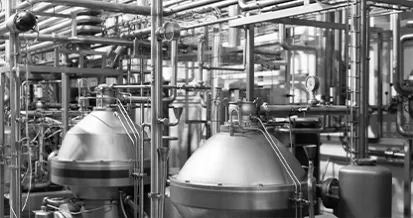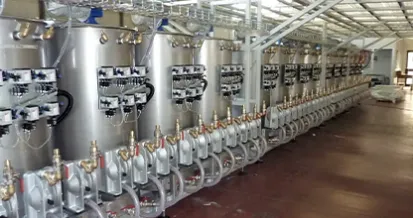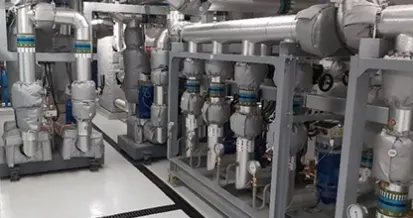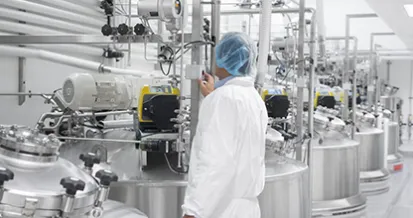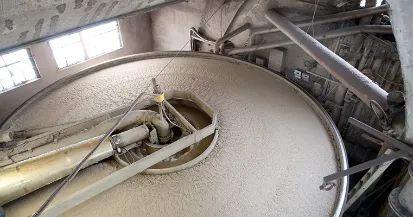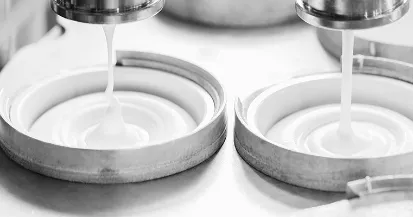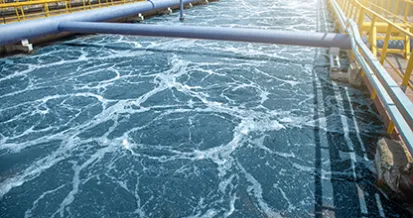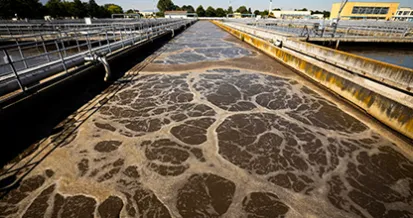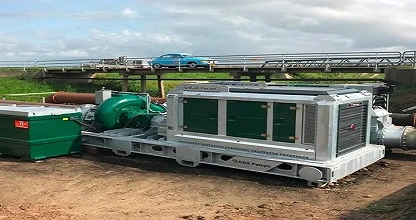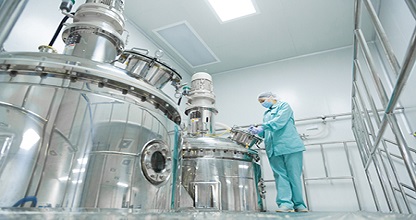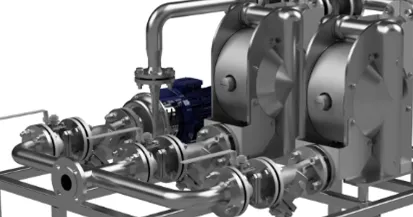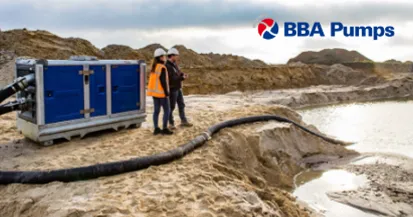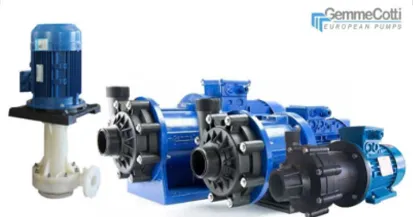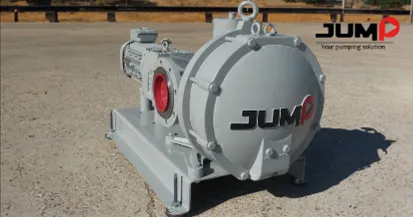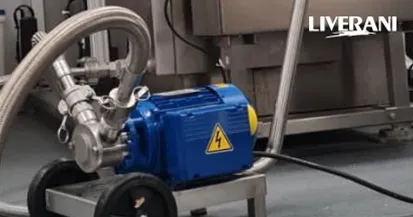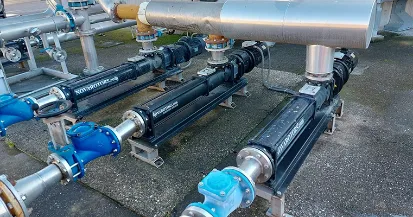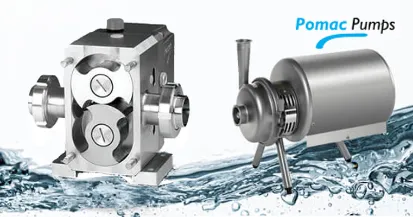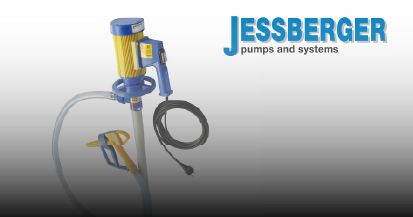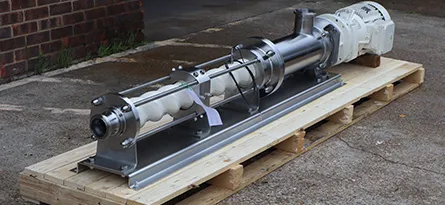What are Self-Priming Pumps?
Self Priming Pumps are types of pumps that can evacuate air from their suction line and prime themselves, without the need for manual intervention or external priming systems. They can draw liquid from a source below the pump’s inlet, typically in installations where the pump is positioned above the fluid level, such as storage tanks or underground reservoirs.
This makes Self-Priming Pumps ideal for situations where air may enter the suction line, such as during start-up or when the pump is stopped. They are particularly useful when regular priming is impractical.
Working Principle & Components that Make a Pump Self-Priming
How Self-Priming Works:
A Self-Priming Pump works by recirculating liquid within the pump casing to create a vacuum that evacuates air from the suction line. Once the air is removed, the pump starts its normal operation by drawing liquid into the impeller, thereby maintaining the flow of fluid.
Key Components of a Self-Priming Pump:
- Pump Casing: Holds enough liquid to cover the impeller for priming
- Impeller: Transfers rotational energy to the fluid, crucial for creating suction and initiating flow
- Volute Chamber: Separates air and liquid to create a vacuum and ensure the pump primes
Wet vs. Dry Self-Priming:
- Wet Self-Priming: The pump needs to be filled with liquid before starting, as the impeller must be submerged to generate suction
- Dry Self-Priming: Pumps that can run dry without damage, typically positive displacement pumps like diaphragm or peristaltic pumps, are designed to handle this
Types of Self-Priming Pumps from Tapflo UK
There are a variety of pumping technologies that can self-prime, including Diaphragm Pumps, Rotary Gear Pumps, Flexible Impeller Pumps and Lobe Pumps. Below is a list of the Self-Priming Pumps available at Tapflo UK:
- Diaphragm Pumps – Our AODD Pumps can self-prime suction 5m dry or 8m wet.
- Peristaltic Pumps – These pumps can self-prime and have a suction of 9.8m dry or wet due to their operating principle.
- Self-Priming Centrifugal Pumps – These pumps have 6m suction, but the head of the pump needs to be prefilled before use.
- Twin Screw Pump – The Pomac Screw Pump, also available as a Double Screw Pump has a self-priming capability of up to 9 metres with water.
- Flexible Impeller Pump – All of our Flexible Impeller Pumps (also known as Flexible Vane Pumps) are self-priming up to 6m dry.
- Self-Priming Mag Drive Pumps – There are 2 ranges available as Self-Priming Pumps, a Magnetically Driven Regenerative Turbine Pump which can self-prim eup to 5m and a Mag Drive Centrifugal Pump which has self-priming capabilities up to 6m.
There are several pumping technologies available that are not self-priming as standard and would require some alterations to make it self-priming capable. As an example Centrifugal Pumps can’t self-prime as standard, however our Self-Priming Centrifugal Pump features a pump casing that is filled with liquid to allow for self-priming to be possible.
Applications of Self-Priming Pumps
Self-Priming Pumps are suited for a variety of challenging applications:
Wastewater & Sewage Handling:
- Municipal Sewage Systems: ideal for lifting/transferring wastewater, sewage, and sludge in municipal networks
- Industrial Wastewater Treatment Plants: effectively handling industrial wastewater containing solids
- Septic Systems: facilitates the movement of sewage and sludge in residential or commercial septic systems
- Solids Handling: their ability to handle and manage solids makes them ideally suited to waste streams that contain debris or large particles
Construction & Dewatering:
- Site Dewatering: used to remove water from construction sites, basements, and excavations
- Sediment and Debris Handling: can pump water mixed with sediment and debris, common in construction environments
- Pit Dewatering: effective in removing water from pits, trenches, and other low-lying areas at construction sites
Irrigation & Agriculture:
- Agricultural Irrigation: pumps water from wells, rivers, or lakes to supply irrigation systems for fields
- Variable Water Sources: their ability to handle different water sources and flow conditions is beneficial for farms
- Agricultural Spraying: pumps are also used to transfer fertilisers, pesticides, and chemicals in spraying systems
Marine & Bilge Pumping:
- Bilge Pumping on Ships and Boats: Removes seawater accumulating in the hull to prevent flooding
- Marine Vessel Applications: Used for ballast systems and other fluid handling tasks on ships
- Seawater Handling: Durable for managing seawater and harsh marine environments
Emergency & Flood Control:
- Flood Control Systems: used to rapidly remove excess water from flood-prone areas
- Emergency Water Management: provides quick responses in flood emergencies by handling large volumes of water efficiently
- Portable Firefighting Systems: often used in emergency situations for flood control and firefighting
Industrial Processes:
- Chemical Transfer: ideal for moving chemicals, solvents, and hazardous liquids in industrial settings
- Food and Beverage Processing: used for transferring fluids such as water, juice, or dairy products in sanitary applications
- Pharmaceutical Production: in pharmaceutical plants, Self-Priming Pumps help in transferring fluids under strict sanitary conditions
- Pulp and Paper Industry: pumps are used for handling slurries, chemicals, and water in the pulp and paper manufacturing process
Firefighting:
- Rapid Water Sourcing: quickly draws water from natural sources (lakes, ponds) or hydrants
- Emergency Response: the ability to self-prime ensures a rapid reaction to fire emergencies in both urban and rural areas
Mining Operations:
- Pit and Tunnel Dewatering: helps remove water from mining pits, tunnels, and quarries
- Slurry Handling: effective in transferring slurry mixtures of water and solid particles in mining environments
Oil & Gas Industry:
- Crude Oil and Refined Products: transfers oil, gases, and liquids in refineries and oil extraction operations
- Gas-Liquid Mixtures: their ability to handle gas-liquid mixtures makes them useful in oil extraction and transport
Municipal Water Supply:
- Water Distribution: pumps water from wells or reservoirs into municipal water supply systems
- Well Pumping: transfers water from groundwater sources to public or private water distribution networks
Pulp & Paper Industry:
- Slurry and Chemical Transfer: used for transferring various fluids in pulp and paper manufacturing, such as water, slurry, and chemicals
- Wastewater Management: removes wastewater from the paper manufacturing process
Agricultural Spraying:
- Fertiliser and Chemical Transfer: used in spraying equipment for transferring pesticides, herbicides, and fertilisers from storage tanks to spraying systems
Hazardous Fluid Transfer:
- ATEX Environments: certified for use in explosive atmospheres where flammable liquids, such as methanol or solvents, need to be handled safely
Pit Emptying and Dewatering:
- Low-Lying Area Management: suitable for dewatering pits, low-lying areas, or underground environments where water accumulates
Solids Handling:
- Debris-Laden Fluids: designed for handling fluids with solids, such as quarry wheel wash systems, wastewater with sludge, or stormwater containing debris
- Quarry and Industrial Wash Systems: commonly used in industrial and quarry operations to wash down equipment and remove contaminated water
Tanker Offloading:
- Complete Tanker Emptying: ensures complete offloading of tankers and storage tanks, preventing issues like vapour lock
- Fuel and Liquid Transfer: commonly used in fuel transfer operations, ensuring complete draining of tanks
Varying Inlet Conditions:
- Fluctuating Water Levels: ideal for situations with variable water levels such as tidal environments or fluctuating groundwater levels
- Remote and Unstable Sources: effective in remote locations with unpredictable or intermittent water sources
Advantages of Self-Priming Pumps
- Entrained Gas Handling: They can handle fluids with air or gas pockets, ensuring effective priming even with gas present in the suction line
- Maintenance: Easier to maintain compared to Submersible Pumps, as they are not immersed in the fluid
- Reliability: No need for additional equipment like check valves, reducing potential failure points
- Versatility: Suitable for a wide range of fluids and conditions
Limitations & Considerations
- Efficiency: Generally less efficient than standard Centrifugal Pumps due to larger internal clearances
- Priming Time: Long priming times can cause overheating, leading to potential damage to seals or gaskets
- Clogging: Although capable of handling solids, strainers may still be necessary to prevent clogging
- Repriming Needs: After extended periods of inactivity, the pump may need to be reprimed manually
How to Select the Right Self-Priming Pump for Your Operation
When selecting a Self-Priming Pump, there are several key factors to consider. First, ensure the pump’s impeller can handle any solids in the fluid, as this will affect performance. The fluid’s viscosity is also crucial, as it influences both the pump’s speed and flow rate. Next, account for the priming distance, while considering any pressure losses caused by valves or bends in the system. It’s important to ensure the pump can handle fluctuating fluid levels and prime within an acceptable timeframe without overheating. Additionally, think about power options – whether electrical, hydraulic, or engine-driven, and select the configuration that suits your needs. Finally, choose the appropriate controls, such as automatic start/stop features, to fit your operation’s requirements.
Installation & Maintenance Tips
Installation:
- Priming: Always fill the casing with liquid before starting
- Suction Line Check: Ensure no air leaks are present, and the discharge line is unobstructed
- Startup Tests: Run the pump to check for vibrations, cavitation, and whether it successfully primes
Maintenance:
- Regular Inspection: Check for leaks, damage, and unusual noises
- Lubrication: Ensure bearings are properly lubricated
- Vibration & Alignment: Check for excessive vibration and alignment issues
- Keep Spare Parts: Maintain a set of critical spare parts for immediate use
What Type of Installation Would We Recommend a Self Priming Pump For?
Before deciding whether you require a Self Priming Pump, it is important to know whether your pump will be installed above the fluid or below it. If your pump will be installed below the fluid, the weight of the fluid will force your product into the pump, therefore you won’t require a Self-Priming pump. However, if your pump is going to be installed above the fluid, the pump will be pulling product out of the tank or storage container and it will be important to decide how much suction is required.
Your pump will be chosen based on the requirements of dry suction and wet suction, as the suctions often differ. For example, if the tank is 5.5m deep and the pump is installed above the tank, you could use a Self-Priming Centrifugal Pump which has a suction of 6m, but if your tank was 9m deep, you would require a Peristaltic Pump or a Diaphragm Pump.
Therefore, we would recommend Self-Priming pumps for installations where the pump is required to be above the fluid.
For more information on Self-Priming Pumps and how the Tapflo UK range can assist with your specific needs, contact us today.

